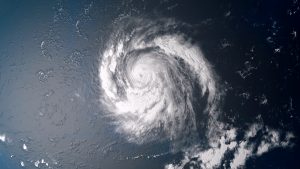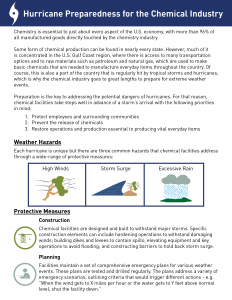As another summer comes to an end, hurricane season in the Atlantic is just reaching its peak with several active storms churning out in the ocean, including Florence. Each season brings an uncomfortable amount of uncertainty as we try to predict the path and severity of each developing storm.
Take Hurricane Harvey for example. It served as an important reminder of what’s at stake and how each storm can bring its own set of unique challenges for everyone in its path. Unlike other hurricanes to hit the United States before it, Harvey dropped an unprecedented 33 trillion gallons of water, 15 trillion of which flooded the Houston, Texas area alone. By all measures it was a historic storm of epic proportions that overwhelmed many in its path displacing more than 30,000 people and causing an estimated $125 billion in damage.
Of course, Harvey was not the first major storm to hit the United States nor will be it the last, which is why planning for the next one is a year-round effort for the chemical industry, especially for facilities along the Gulf Coast. A large share of the chemical production in the United States is located in Texas and Louisiana because of access to many transportation options and to raw materials such as petroleum and natural gas, which are used to make basic chemicals that are needed to manufacture everyday items throughout the country.
Since storms present a real risk to these vital operations, facility operators stress the importance of planning early and not waiting until the next hurricane season rolls around to take action. Planning for extreme weather events typically involves focusing on three phases: preparation, response, and recovery.
Preparation
Once a storm hits a manufacturing facility, its response options can be severely limited, therefore much of the outcome is dependent on what a facility has done upfront to minimize the impact of a storm.
Preparedness starts as early as when a company begins construction of a facility. Many years of experience have taught companies that flooding presents a real risk to the operation of a facility and the safety of employees, which is why an important part of planning a new facility - and the government permitting process - includes consideration of floodplain data.
 Extreme weather events also have a major influence in how facilities are designed. There are three elements of a hurricane that can damage a facility: high winds, storm surge, and excessive rain. The severity of hurricanes is usually based on the first two elements, but Hurricane Harvey provided a strong reminder not to underestimate the damaging effects from extreme rainfall.
Extreme weather events also have a major influence in how facilities are designed. There are three elements of a hurricane that can damage a facility: high winds, storm surge, and excessive rain. The severity of hurricanes is usually based on the first two elements, but Hurricane Harvey provided a strong reminder not to underestimate the damaging effects from extreme rainfall.
Designing a facility to withstand a storm involves erecting physical barriers to keep the water and wind at bay — everything from door and window seals to storm berms, which are used to both protect storage tanks and contain spills. Companies also elevate critical infrastructure, like the control room and backup generators, so it’s more difficult for the flood waters to reach.
In addition to planning early, facilities also understand the importance of building relationships before they are needed. Dealing with a hurricane extends well beyond the fence line of a facility and requires close coordination with local emergency responders. Everyone needs to be on the same page well before a storm hits, which is why companies work closely with their local emergency planning committees, or LEPCs, to establish points of contact and contingency plans well ahead of time.
None of this planning and preparation is treated as a one-time thing. Chemical companies review and revise these plans on a regular basis to incorporate lessons learned from previous storms and any new site-specific information or safety practices.
Response
As a storm approaches, chemical companies need reliable minute-by-minute projections for when the storm will impact the facility, projections that require more than your standard Weather Channel forecasts. Companies subscribe to specialized weather forecasting services to ensure that they have the most accurate and up to date projections on the severity and path of incoming storms to activate their emergency plans.
The early stages of those plans include testing backup generators, taking stock of emergency supplies and securing loose or vulnerable materials and equipment. As conditions worsen operators begin to evacuate non-essential personnel and ensure they are able to track employees and to obtain outside assistance if needed.
One of the most vital decisions a company makes during a storm is whether to shut down a facility or keep it in operation. While an outside observer might think it’s always prudent to cease operations, it’s the shutting down and starting up of a facility that presents the greatest risk, so in many cases, it’s better from an environmental and safety standpoint to maintain operations during a storm.
Ride-out crews are often kept at a safe, predetermined location to monitor the facility and report or address any incidents that result from the impact of the storm. The crews consist of employees who are well trained to deal with emergency situations and make on the spot decisions to keep everyone safe.
Recovery
Eventually the storm passes, and the focus shifts from weathering the storm to getting people back on their feet and bringing operations back online.
Assisting employees is the first order of business following a storm. This includes everything from making sure employees and their families have a safe place to stay and the ability to travel to work. In some cases, this involves renting out large blocks of hotel rooms or purchasing trailers and other temporary housing.
The full extent of damage from a storm might not be immediately obvious so restoring operations is done with extreme care. It begins with bringing in an inspection crew to conduct a thorough assessment of the site’s condition before allowing other employees to come back to work.
Recovery also extends well beyond the fence line of a facility, to neighbors and into surrounding communities. Companies donate money, supplies, and even labor to help others who were displaced by the hurricane. The most recent example of this effort was in the wake of Hurricane Harvey when companies donated equipment and money to help communities in the Houston area, and thousands of chemical industry employees aided in refurbishing homes and rescued those stranded by the flood waters.
Looking Ahead
Every storm leaves us with lessons that can be used to get ready for the next storm, which unfortunately is definitely coming. Harvey taught us many new things: to prepare for longer duration events that can last for days not just hours, to build stronger and more comprehensive support networks for obtaining and sharing information, and that we need to double our efforts as a nation to rebuild our critical infrastructure to help better weather these extreme storms.
Extreme weather events can certainly be unpredictable but a well-orchestrated plan can help tackle unwanted surprises. As we can see from the predictions for increased and more extreme storms in the future, the next test for our industry is just be around the corner.
You can learn more about hurricane safety and the chemical industry here.